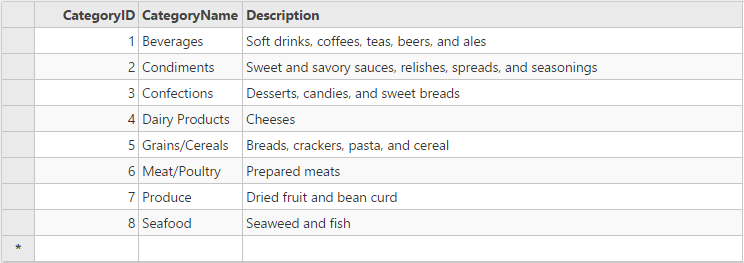The quick start guides you through the steps of adding FlexGrid control in your MVC web application and adding data to it using CollectionView class. Complete the following steps to see how the FlexGrid control appears after data binding:

Create a new MVC application using the ComponentOne or VisualStudio templates. For more information about creating an MVC application, see Configuring your MVC Application topic.
The example uses C1NWind database. The C1NWind.mdf file is available on your system at the following location:
Documents\ComponentOne Samples\ASP.NET MVC\MVC\MvcExplorer\App_Data
AppData folder in the Solution Explorer.Models|Add New Item|Data, and select ADO.NET Entity Data Model.Tables, and click Finish.If you can see C1NWind.edmx added to your project under the Models folder, you have successfully configured the data source for your application.
Back to TopComplete the following steps to initialize a FlexGrid control.
Add a new Controller
Default1Controller).| C# |
Copy Code
|
|---|---|
using System; using System.Collections.Generic; using System.Linq; using System.Web; using System.Web.Mvc; using CollectionView_EN.Models; using C1.Web.Mvc.Grid; using C1.Web.Mvc; using C1.Web.Mvc.Serializition; using System.Data.Entity.Validation; using System.Data.Entity; using System.Data; |
|
IndexController.cs
| C# |
Copy Code
|
|---|---|
//Define datasource for FlexGrid private C1NWindEntities db = new C1NWindEntities(); public ActionResult Index() { return View(); } //Instantiate a JSON request public ActionResult GridReadCategory([C1JsonRequest] CollectionViewRequest<Category> requestData) { return this.C1Json(CollectionViewHelper.Read(requestData, db.Categories)); } |
|
Add a View for the controller:
Default1Controller) to open it.Index().Index.cshtml to open it.In this example, the GridReadCategory action of controller is assigned to Bind property of FlexGrid' ItemSource to populate data.
| HTML |
Copy Code
|
|---|---|
<c1-flex-grid id="fGRCView" auto-generate-columns="false" allow-add-new="true" allow-sorting="true" class="grid"> <c1-items-source read-action-url="@Url.Action("GridReadCategory")"></c1-items-source> <c1-flex-grid-column binding="CategoryID"></c1-flex-grid-column> <c1-flex-grid-column binding="CompanyName"></c1-flex-grid-column> <c1-flex-grid-column binding="Description"></c1-flex-grid-column> </c1-flex-grid> |
|